Full text
PDF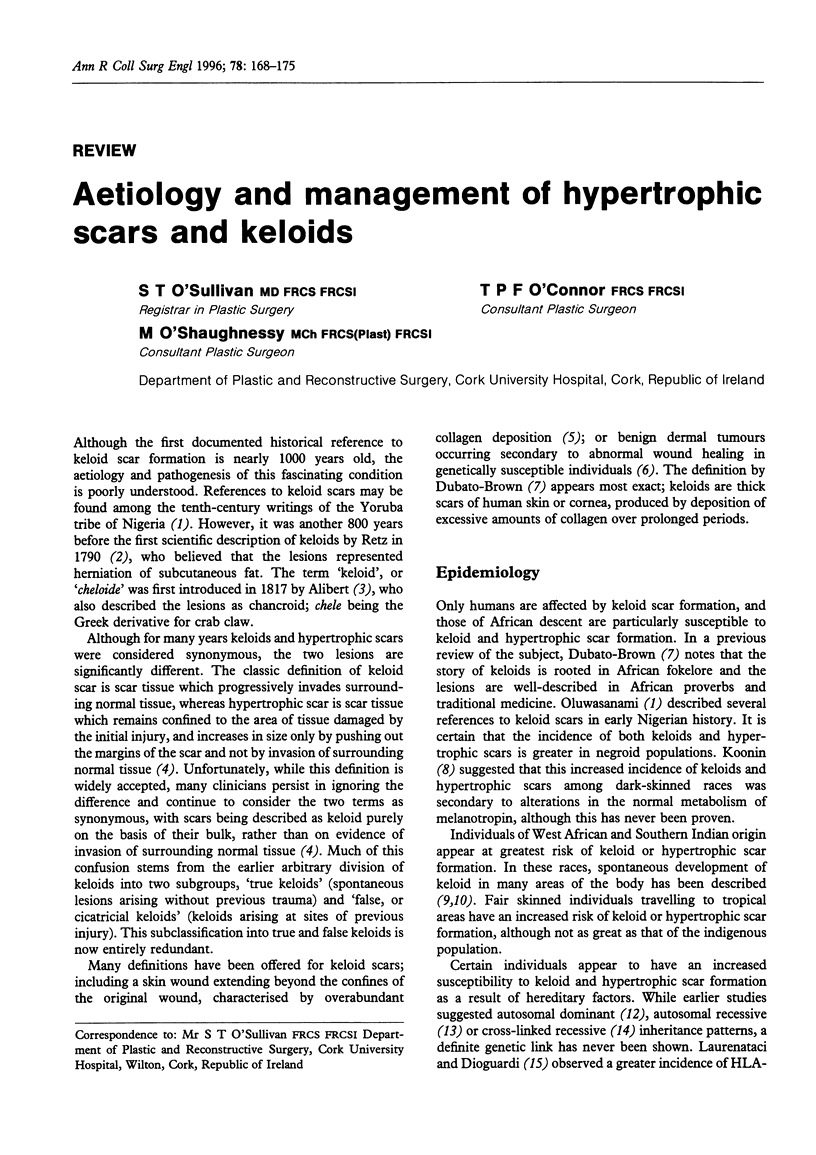

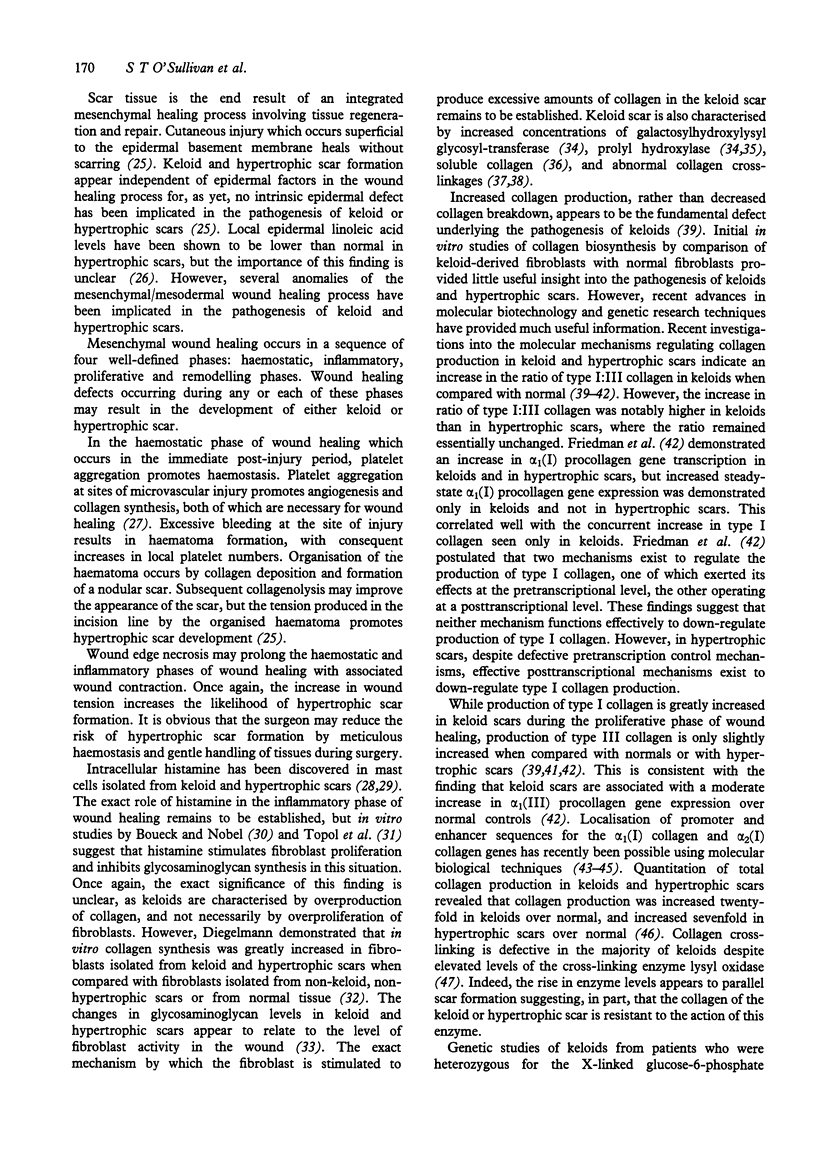
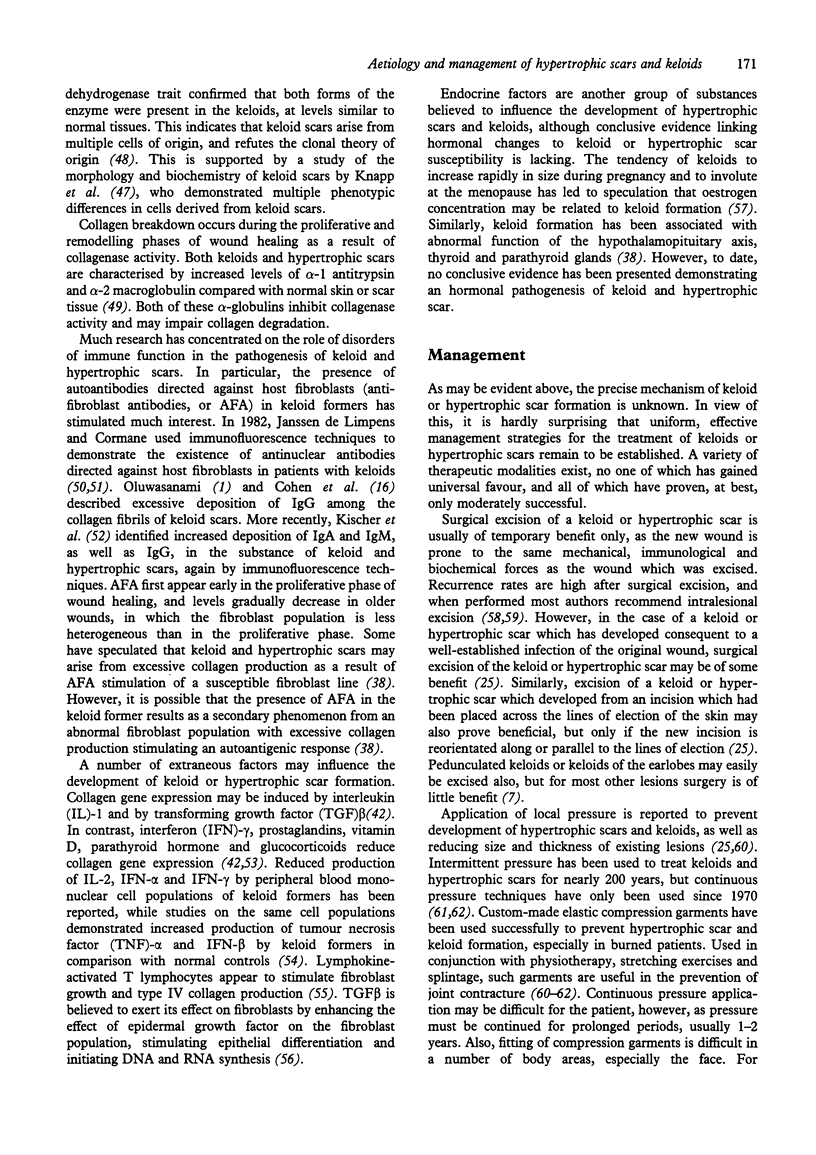
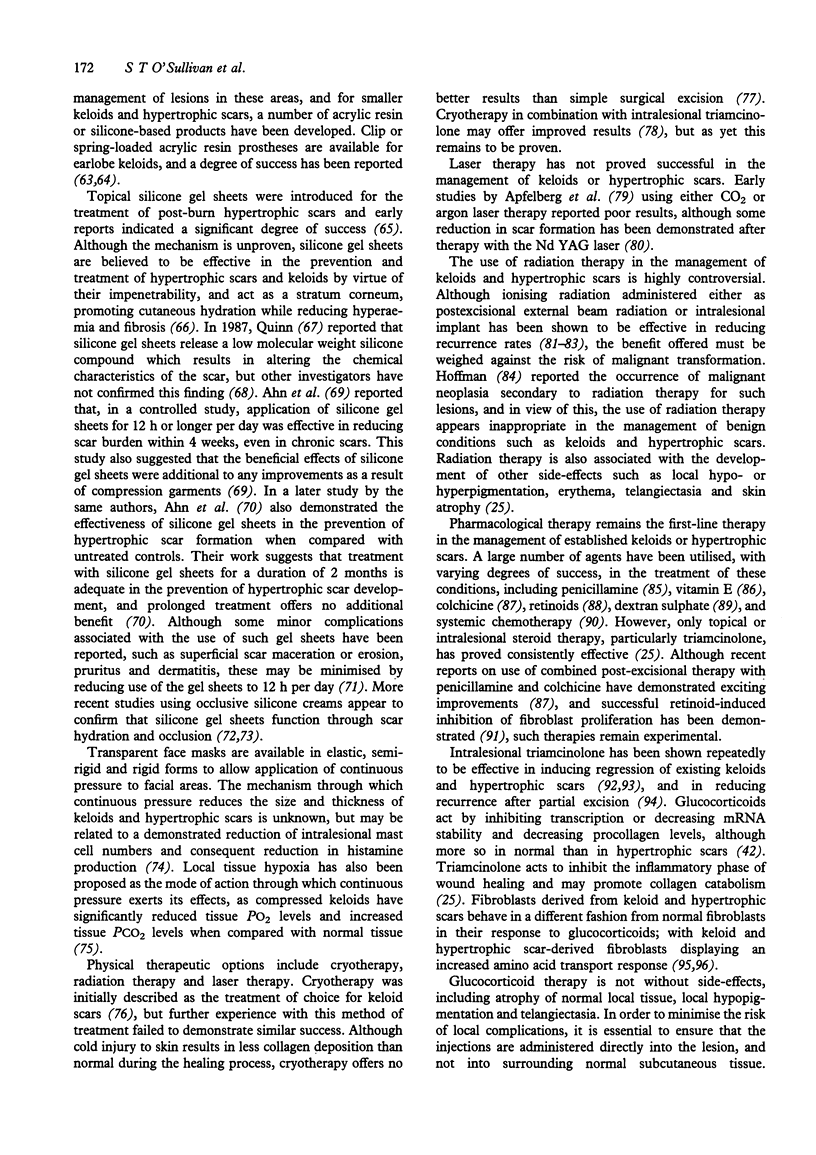
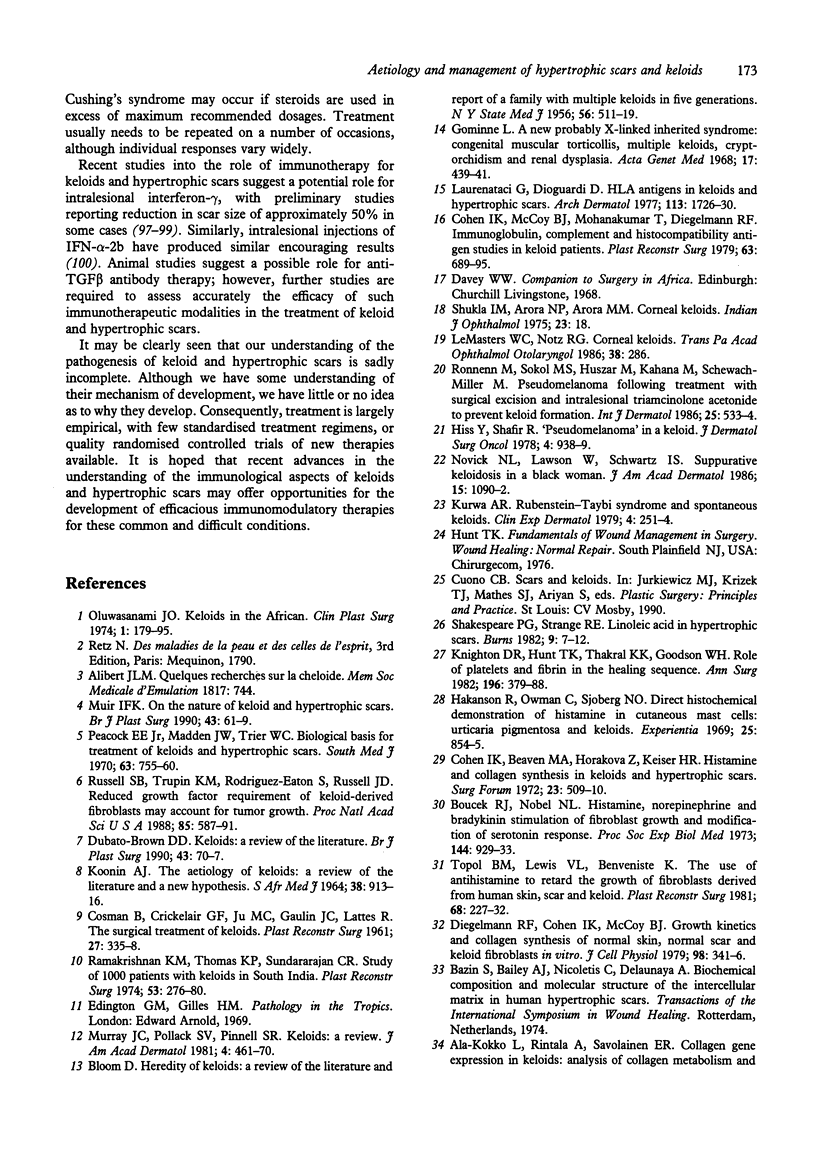
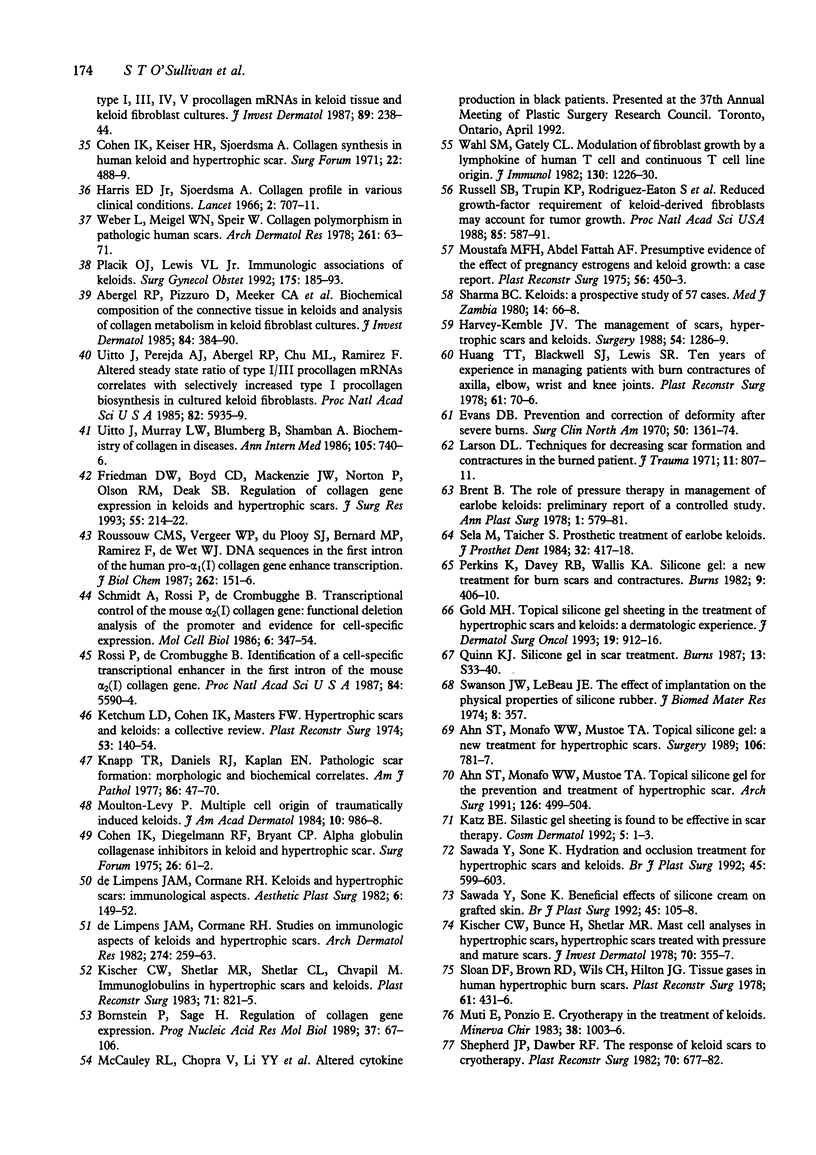
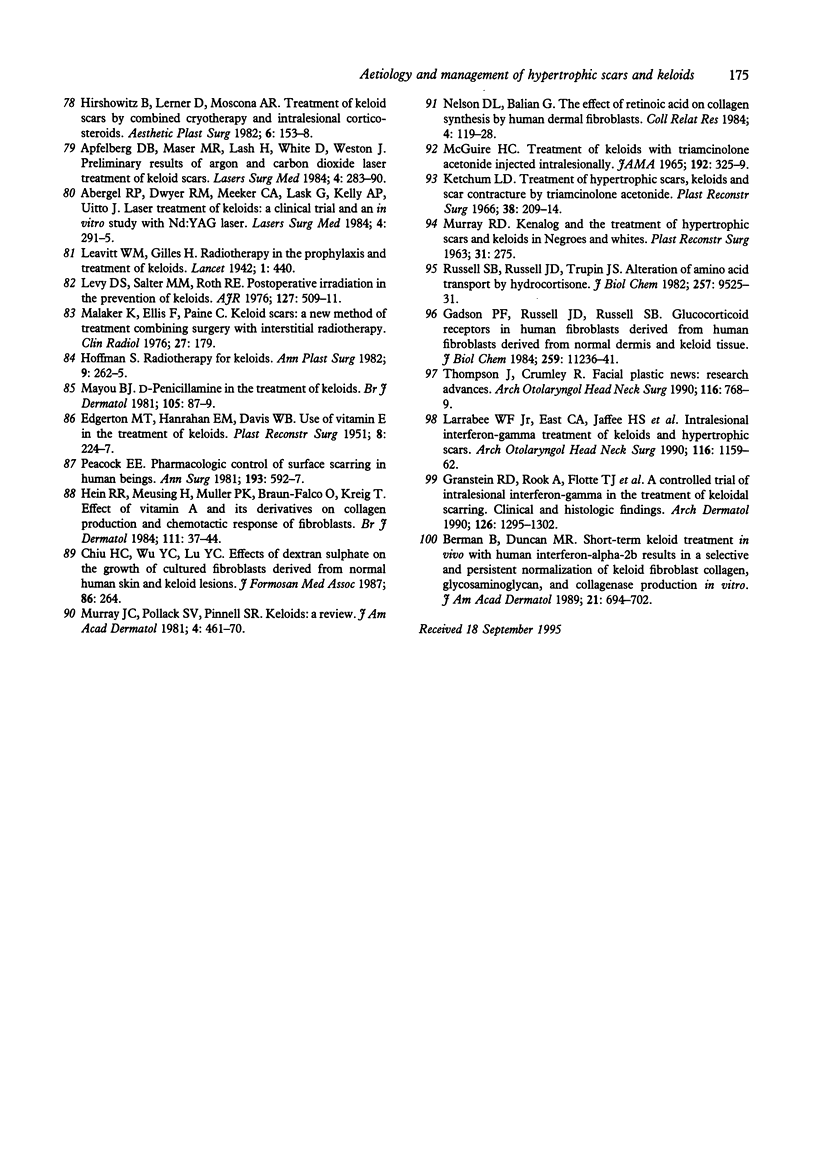
Selected References
These references are in PubMed. This may not be the complete list of references from this article.
- Abergel R. P., Dwyer R. M., Meeker C. A., Lask G., Kelly A. P., Uitto J. Laser treatment of keloids: a clinical trial and an in vitro study with Nd:YAG laser. Lasers Surg Med. 1984;4(3):291–295. doi: 10.1002/lsm.1900040310. [DOI] [PubMed] [Google Scholar]
- Abergel R. P., Pizzurro D., Meeker C. A., Lask G., Matsuoka L. Y., Minor R. R., Chu M. L., Uitto J. Biochemical composition of the connective tissue in keloids and analysis of collagen metabolism in keloid fibroblast cultures. J Invest Dermatol. 1985 May;84(5):384–390. doi: 10.1111/1523-1747.ep12265471. [DOI] [PubMed] [Google Scholar]
- Ahn S. T., Monafo W. W., Mustoe T. A. Topical silicone gel for the prevention and treatment of hypertrophic scar. Arch Surg. 1991 Apr;126(4):499–504. doi: 10.1001/archsurg.1991.01410280103016. [DOI] [PubMed] [Google Scholar]
- Ahn S. T., Monafo W. W., Mustoe T. A. Topical silicone gel: a new treatment for hypertrophic scars. Surgery. 1989 Oct;106(4):781–787. [PubMed] [Google Scholar]
- Ala-Kokko L., Rintala A., Savolainen E. R. Collagen gene expression in keloids: analysis of collagen metabolism and type I, III, IV, and V procollagen mRNAs in keloid tissue and keloid fibroblast cultures. J Invest Dermatol. 1987 Sep;89(3):238–244. doi: 10.1111/1523-1747.ep12471056. [DOI] [PubMed] [Google Scholar]
- Apfelberg D. B., Maser M. R., Lash H., White D., Weston J. Preliminary results of argon and carbon dioxide laser treatment of keloid scars. Lasers Surg Med. 1984;4(3):283–290. doi: 10.1002/lsm.1900040309. [DOI] [PubMed] [Google Scholar]
- BLOOM D. Heredity of keloids; review of the literature and report of a family with multiple keloids in five generations. N Y State J Med. 1956 Feb 15;56(4):511–519. [PubMed] [Google Scholar]
- Berman B., Duncan M. R. Short-term keloid treatment in vivo with human interferon alfa-2b results in a selective and persistent normalization of keloidal fibroblast collagen, glycosaminoglycan, and collagenase production in vitro. J Am Acad Dermatol. 1989 Oct;21(4 Pt 1):694–702. doi: 10.1016/s0190-9622(89)70239-5. [DOI] [PubMed] [Google Scholar]
- Bornstein P., Sage H. Regulation of collagen gene expression. Prog Nucleic Acid Res Mol Biol. 1989;37:67–106. doi: 10.1016/s0079-6603(08)60695-9. [DOI] [PubMed] [Google Scholar]
- Boucek R. J., Noble N. L. Histamine, norepinephrine, and bradykinin stimulation of fibroblast growth and modification of serotonin response. Proc Soc Exp Biol Med. 1973 Dec;144(3):929–933. doi: 10.3181/00379727-144-37714. [DOI] [PubMed] [Google Scholar]
- Brent B. The role of pressure therapy in management of earlobe keloids: preliminary report of a controlled study. Ann Plast Surg. 1978 Nov;1(6):579–581. doi: 10.1097/00000637-197811000-00008. [DOI] [PubMed] [Google Scholar]
- Cohen I. K., Beaven M. A., Horáková Z., Keiser H. R. Histamine and collagen synthesis in keloid and hypertrophic scar. Surg Forum. 1972;23(0):509–510. [PubMed] [Google Scholar]
- Cohen I. K., Diegelmann R. F., Bryant C. P. Alpha globulin collagenase inhibitors in keloid and hypertrophic scar. Surg Forum. 1975;26:61–62. [PubMed] [Google Scholar]
- Cohen I. K., Keiser H. R., Sjoerdsma A. Collagen synthesis in human keloid and hypertrophic scar. Surg Forum. 1971;22:488–489. [PubMed] [Google Scholar]
- Cohen I. K., McCoy B. J., Mohanakumar T., Diegelmann R. F. Immunoglobulin, complement, and histocompatibility antigen studies in keloid patients. Plast Reconstr Surg. 1979 May;63(5):689–695. doi: 10.1097/00006534-197905000-00013. [DOI] [PubMed] [Google Scholar]
- Diegelmann R. F., Cohen I. K., McCoy B. J. Growth kinetics and collagen synthesis of normal skin, normal scar and keloid fibroblasts in vitro. J Cell Physiol. 1979 Feb;98(2):341–346. doi: 10.1002/jcp.1040980210. [DOI] [PubMed] [Google Scholar]
- EDGERTON M. T., Jr, HANRAHAN E. M., DAVIS W. B. Use of vitamin E in the treatment of keloids. Plast Reconstr Surg (1946) 1951 Sep;8(3):224–233. doi: 10.1097/00006534-195109000-00006. [DOI] [PubMed] [Google Scholar]
- Evans E. B., Larson D. L., Abston S., Willis B. Prevention and correction of deformity after severe burns. Surg Clin North Am. 1970 Dec;50(6):1361–1375. doi: 10.1016/s0039-6109(16)39294-5. [DOI] [PubMed] [Google Scholar]
- Friedman D. W., Boyd C. D., Mackenzie J. W., Norton P., Olson R. M., Deak S. B. Regulation of collagen gene expression in keloids and hypertrophic scars. J Surg Res. 1993 Aug;55(2):214–222. doi: 10.1006/jsre.1993.1132. [DOI] [PubMed] [Google Scholar]
- Gadson P. F., Russell J. D., Russell S. B. Glucocorticoid receptors in human fibroblasts derived from normal dermis and keloid tissue. J Biol Chem. 1984 Sep 25;259(18):11236–11241. [PubMed] [Google Scholar]
- Gold M. H. Topical silicone gel sheeting in the treatment of hypertrophic scars and keloids. A dermatologic experience. J Dermatol Surg Oncol. 1993 Oct;19(10):912–916. doi: 10.1111/j.1524-4725.1993.tb00978.x. [DOI] [PubMed] [Google Scholar]
- Granstein R. D., Rook A., Flotte T. J., Haas A., Gallo R. L., Jaffe H. S., Amento E. P. A controlled trial of intralesional recombinant interferon-gamma in the treatment of keloidal scarring. Clinical and histologic findings. Arch Dermatol. 1990 Oct;126(10):1295–1302. [PubMed] [Google Scholar]
- Harris E. D., Jr, Sjoerdsma A. Collagen profile in various clinical conditions. Lancet. 1966 Oct 1;2(7466):707–711. doi: 10.1016/s0140-6736(66)92976-x. [DOI] [PubMed] [Google Scholar]
- Hein R., Mensing H., Müller P. K., Braun-Falco O., Krieg T. Effect of vitamin A and its derivatives on collagen production and chemotactic response of fibroblasts. Br J Dermatol. 1984 Jul;111(1):37–44. doi: 10.1111/j.1365-2133.1984.tb04014.x. [DOI] [PubMed] [Google Scholar]
- Hirshowitz B., Lerner D., Moscona A. R. Treatment of keloid scars by combined cryosurgery and intralesional corticosteroids. Aesthetic Plast Surg. 1982;6(3):153–158. doi: 10.1007/BF01570635. [DOI] [PubMed] [Google Scholar]
- Hiss Y., Shafir R. "Pseudomelanoma" in a keloid. J Dermatol Surg Oncol. 1978 Dec;4(12):938–939. doi: 10.1111/j.1524-4725.1978.tb00587.x. [DOI] [PubMed] [Google Scholar]
- Huang T. T., Blackwell S. J., Lewis S. R. Ten years of experience in managing patients with burn contractures of axilla, elbow, wrist, and knee joints. Plast Reconstr Surg. 1978 Jan;61(1):70–76. doi: 10.1097/00006534-197801000-00012. [DOI] [PubMed] [Google Scholar]
- Håkanson R., Owman C., Sjöberg N. O., Sporrong B. Direct histochemical demonstration of histamine in cutaneous mast cells: urticaria pigmentosa and keloids. Experientia. 1969 Aug 15;25(8):854–855. doi: 10.1007/BF01897918. [DOI] [PubMed] [Google Scholar]
- Janssen de Limpens A. M., Cormane R. H. Keloids and hypertrophic scars--immunological aspects. Aesthetic Plast Surg. 1982;6(3):149–152. doi: 10.1007/BF01570634. [DOI] [PubMed] [Google Scholar]
- Janssen de Limpens A. M., Cormane R. H. Studies on the immunologic aspects of keloids and hypertrophic scars. Arch Dermatol Res. 1982;274(3-4):259–266. doi: 10.1007/BF00403728. [DOI] [PubMed] [Google Scholar]
- KOONIN A. J. THE AETIOLOGY OF KELOIDS: A REVIEW OF THE LITERATURE AND A NEW HYPOTHESIS. S Afr Med J. 1964 Nov 21;38:913–916. [PubMed] [Google Scholar]
- Ketchum L. D., Cohen I. K., Masters F. W. Hypertrophic scars and keloids. A collective review. Plast Reconstr Surg. 1974 Feb;53(2):140–154. doi: 10.1097/00006534-197402000-00004. [DOI] [PubMed] [Google Scholar]
- Ketchum L. D., Smith J., Robinson D. W., Masters F. W. The treatment of hypertrophic scar, keloid and scar contracture by triamcinolone acetonide. Plast Reconstr Surg. 1966 Sep;38(3):209–218. doi: 10.1097/00006534-196609000-00005. [DOI] [PubMed] [Google Scholar]
- Kischer C. W., Bunce H., 3rd, Shetlah M. R. Mast cell analyses in hypertrophic scars, hypertrophic scars treated with pressure and mature scars. J Invest Dermatol. 1978 Jun;70(6):355–357. doi: 10.1111/1523-1747.ep12543553. [DOI] [PubMed] [Google Scholar]
- Kischer C. W., Shetlar M. R., Shetlar C. L., Chvapil M. Immunoglobulins in hypertrophic scars and keloids. Plast Reconstr Surg. 1983 Jun;71(6):821–825. doi: 10.1097/00006534-198306000-00015. [DOI] [PubMed] [Google Scholar]
- Knapp T. R., Daniels R. J., Kaplan E. N. Pathologic scar formation. Morphologic and biochemical correlates. Am J Pathol. 1977 Jan;86(1):47–70. [PMC free article] [PubMed] [Google Scholar]
- Knighton D. R., Hunt T. K., Thakral K. K., Goodson W. H., 3rd Role of platelets and fibrin in the healing sequence: an in vivo study of angiogenesis and collagen synthesis. Ann Surg. 1982 Oct;196(4):379–388. doi: 10.1097/00000658-198210000-00001. [DOI] [PMC free article] [PubMed] [Google Scholar]
- Kurwa A. R. Rubinstein-Taybi syndrome and spontaneous keloids. Clin Exp Dermatol. 1979 Jun;4(2):251–254. doi: 10.1111/j.1365-2230.1979.tb01627.x. [DOI] [PubMed] [Google Scholar]
- Larrabee W. F., Jr, East C. A., Jaffe H. S., Stephenson C., Peterson K. E. Intralesional interferon gamma treatment for keloids and hypertrophic scars. Arch Otolaryngol Head Neck Surg. 1990 Oct;116(10):1159–1162. doi: 10.1001/archotol.1990.01870100053011. [DOI] [PubMed] [Google Scholar]
- Larson D. L., Abston S., Evans E. B., Dobrkovsky M., Linares H. A. Techniques for decreasing scar formation and contractures in the burned patient. J Trauma. 1971 Oct;11(10):807–823. doi: 10.1097/00005373-197110000-00001. [DOI] [PubMed] [Google Scholar]
- Laurentaci G., Dioguardi D. HLA antigens in keloids and hypertrophic scars. Arch Dermatol. 1977 Dec;113(12):1726–1726. [PubMed] [Google Scholar]
- LeMasters W. C., Notz R. G. Corneal keloids. Trans Pa Acad Ophthalmol Otolaryngol. 1986;38(1):286–288. [PubMed] [Google Scholar]
- Levy D. S., Salter M. M., Roth R. E. Postoperative irradiation in the prevention of keloids. AJR Am J Roentgenol. 1976 Sep;127(3):509–510. doi: 10.2214/ajr.127.3.509. [DOI] [PubMed] [Google Scholar]
- MAGUIRE H. C., Jr TREATMENT OF KELOIDS WITH TRIAMCINOLONE ACETONIDE INJECTED INTRALESIONALLY. JAMA. 1965 Apr 26;192:325–326. doi: 10.1001/jama.1965.03080170053019. [DOI] [PubMed] [Google Scholar]
- MURRAY R. D. Kenalog and the treatment of hypertrophied scars and keloids in Negroes and whites. Plast Reconstr Surg. 1963 Mar;31:275–280. doi: 10.1097/00006534-196303000-00007. [DOI] [PubMed] [Google Scholar]
- Malaker A., Ellis F., Paine C. H. Keloid scars: a new method of treatment combining surgery with interstitial radiotherapy. Clin Radiol. 1976 Apr;27(2):179–183. doi: 10.1016/s0009-9260(76)80141-9. [DOI] [PubMed] [Google Scholar]
- Mayou B. J. D-Penicillamine in the treatment of keloids. Br J Dermatol. 1981 Jul;105(1):87–89. doi: 10.1111/j.1365-2133.1981.tb00887.x. [DOI] [PubMed] [Google Scholar]
- Moulton-Levy P., Jackson C. E., Levy H. G., Fialkow P. J. Multiple cell origin of traumatically induced keloids. J Am Acad Dermatol. 1984 Jun;10(6):986–988. doi: 10.1016/s0190-9622(84)80319-9. [DOI] [PubMed] [Google Scholar]
- Moustafa M. F., Abdel-Fattah M. A., Abdel-Fattah D. C. Presumptive evidence of the effect of pregnancy estrogens on keloid growth. Case report. Plast Reconstr Surg. 1975 Oct;56(4):450–453. doi: 10.1097/00006534-197510000-00019. [DOI] [PubMed] [Google Scholar]
- Muir I. F. On the nature of keloid and hypertrophic scars. Br J Plast Surg. 1990 Jan;43(1):61–69. doi: 10.1016/0007-1226(90)90046-3. [DOI] [PubMed] [Google Scholar]
- Murray J. C., Pollack S. V., Pinnell S. R. Keloids: a review. J Am Acad Dermatol. 1981 Apr;4(4):461–470. doi: 10.1016/s0190-9622(81)70048-3. [DOI] [PubMed] [Google Scholar]
- Murray J. C., Pollack S. V., Pinnell S. R. Keloids: a review. J Am Acad Dermatol. 1981 Apr;4(4):461–470. doi: 10.1016/s0190-9622(81)70048-3. [DOI] [PubMed] [Google Scholar]
- Muti E., Ponzio E. Cheloidi: possibilità di trattamento con la crioterapia. Minerva Chir. 1983 Jun 30;38(12):1003–1006. [PubMed] [Google Scholar]
- Nelson D. L., Balian G. The effect of retinoic acid on collagen synthesis by human dermal fibroblasts. Coll Relat Res. 1984 Mar;4(2):119–128. doi: 10.1016/s0174-173x(84)80020-5. [DOI] [PubMed] [Google Scholar]
- Novick N. L., Lawson W., Schwartz I. S. Suppurative keloidosis in a black woman. J Am Acad Dermatol. 1986 Nov;15(5 Pt 2):1090–1092. doi: 10.1016/s0190-9622(86)70270-3. [DOI] [PubMed] [Google Scholar]
- Oluwasanmi J. O. Keloids in the African. Clin Plast Surg. 1974 Jan;1(1):179–195. [PubMed] [Google Scholar]
- Peacock E. E., Jr, Madden J. W., Trier W. C. Biologic basis for the treatment of keloids and hypertrophic scars. South Med J. 1970 Jul;63(7):755–760. doi: 10.1097/00007611-197007000-00002. [DOI] [PubMed] [Google Scholar]
- Peacock E. E., Jr Pharmacologic control of surface scarring in human beings. Ann Surg. 1981 May;193(5):592–597. doi: 10.1097/00000658-198105000-00008. [DOI] [PMC free article] [PubMed] [Google Scholar]
- Placik O. J., Lewis V. L., Jr Immunologic associations of keloids. Surg Gynecol Obstet. 1992 Aug;175(2):185–193. [PubMed] [Google Scholar]
- Quinn K. J. Silicone gel in scar treatment. Burns Incl Therm Inj. 1987 Oct;13 (Suppl):S33–S40. doi: 10.1016/0305-4179(87)90091-x. [DOI] [PubMed] [Google Scholar]
- Ramakrishnan K. M., Thomas K. P., Sundararajan C. R. Study of 1,000 patients with keloids in South India. Plast Reconstr Surg. 1974 Mar;53(3):276–280. doi: 10.1097/00006534-197403000-00004. [DOI] [PubMed] [Google Scholar]
- Ronnen M., Sokol M. S., Huszar M., Kahana M., Schewach-Millet M. Pseudomelanoma following treatment with surgical excision and intralesional triamcinolone acetonide to prevent keloid formation. Int J Dermatol. 1986 Oct;25(8):533–534. doi: 10.1111/j.1365-4362.1986.tb00874.x. [DOI] [PubMed] [Google Scholar]
- Rossi P., de Crombrugghe B. Identification of a cell-specific transcriptional enhancer in the first intron of the mouse alpha 2 (type I) collagen gene. Proc Natl Acad Sci U S A. 1987 Aug;84(16):5590–5594. doi: 10.1073/pnas.84.16.5590. [DOI] [PMC free article] [PubMed] [Google Scholar]
- Russell S. B., Russell J. D., Trupin J. S. Alteration of amino acid transport by hydrocortisone. Different effects in human fibroblasts derived from normal skin and keloid. J Biol Chem. 1982 Aug 25;257(16):9525–9531. [PubMed] [Google Scholar]
- Russell S. B., Trupin K. M., Rodríguez-Eaton S., Russell J. D., Trupin J. S. Reduced growth-factor requirement of keloid-derived fibroblasts may account for tumor growth. Proc Natl Acad Sci U S A. 1988 Jan;85(2):587–591. doi: 10.1073/pnas.85.2.587. [DOI] [PMC free article] [PubMed] [Google Scholar]
- Russell S. B., Trupin K. M., Rodríguez-Eaton S., Russell J. D., Trupin J. S. Reduced growth-factor requirement of keloid-derived fibroblasts may account for tumor growth. Proc Natl Acad Sci U S A. 1988 Jan;85(2):587–591. doi: 10.1073/pnas.85.2.587. [DOI] [PMC free article] [PubMed] [Google Scholar]
- Sawada Y., Sone K. Beneficial effects of silicone cream on grafted skin. Br J Plast Surg. 1992 Feb-Mar;45(2):105–108. doi: 10.1016/0007-1226(92)90167-v. [DOI] [PubMed] [Google Scholar]
- Sawada Y., Sone K. Hydration and occlusion treatment for hypertrophic scars and keloids. Br J Plast Surg. 1992 Nov-Dec;45(8):599–603. doi: 10.1016/0007-1226(92)90027-u. [DOI] [PubMed] [Google Scholar]
- Schmidt A., Rossi P., de Crombrugghe B. Transcriptional control of the mouse alpha 2(I) collagen gene: functional deletion analysis of the promoter and evidence for cell-specific expression. Mol Cell Biol. 1986 Feb;6(2):347–354. doi: 10.1128/mcb.6.2.347. [DOI] [PMC free article] [PubMed] [Google Scholar]
- Sela M., Taicher S. Prosthetic treatment of earlobe keloids. J Prosthet Dent. 1984 Sep;52(3):417–418. doi: 10.1016/0022-3913(84)90458-x. [DOI] [PubMed] [Google Scholar]
- Shakespeare P. G., Strange R. E. Linoleic acid in hypertrophic scars. Burns Incl Therm Inj. 1982 Sep;9(1):7–12. doi: 10.1016/0305-4179(82)90128-0. [DOI] [PubMed] [Google Scholar]
- Shepherd J. P., Dawber R. P. The response of keloid scars to cryosurgery. Plast Reconstr Surg. 1982 Dec;70(6):677–682. doi: 10.1097/00006534-198212000-00003. [DOI] [PubMed] [Google Scholar]
- Shukla I. M., Arora N. P., Arora M. M. Corneal keloid. Indian J Ophthalmol. 1975 Jul;23(2):18–19. [PubMed] [Google Scholar]
- Sloan D. F., Brown R. D., Wells C. H., Hilton J. G. Tissue gases in human hypertrophic burn scars. Plast Reconstr Surg. 1978 Mar;61(3):431–436. doi: 10.1097/00006534-197803000-00018. [DOI] [PubMed] [Google Scholar]
- Swanson J. W., Lebeau J. E. The effect of implantation on the physical properties of silicone rubber. J Biomed Mater Res. 1974 Nov;8(6):357–367. doi: 10.1002/jbm.820080603. [DOI] [PubMed] [Google Scholar]
- Topol B. M., Lewis V. L., Jr, Benveniste K. The use of antihistamine to retard the growth of fibroblasts derived from human skin, scar, and keloid. Plast Reconstr Surg. 1981 Aug;68(2):227–232. doi: 10.1097/00006534-198108000-00018. [DOI] [PubMed] [Google Scholar]
- Uitto J., Murray L. W., Blumberg B., Shamban A. UCLA conference. Biochemistry of collagen in diseases. Ann Intern Med. 1986 Nov;105(5):740–756. doi: 10.7326/0003-4819-105-5-740. [DOI] [PubMed] [Google Scholar]
- Uitto J., Perejda A. J., Abergel R. P., Chu M. L., Ramirez F. Altered steady-state ratio of type I/III procollagen mRNAs correlates with selectively increased type I procollagen biosynthesis in cultured keloid fibroblasts. Proc Natl Acad Sci U S A. 1985 Sep;82(17):5935–5939. doi: 10.1073/pnas.82.17.5935. [DOI] [PMC free article] [PubMed] [Google Scholar]
- Wahl S. M., Gately C. L. Modulation of fibroblast growth by a lymphokine of human T cell continuous T cell line origin. J Immunol. 1983 Mar;130(3):1226–1230. [PubMed] [Google Scholar]
- Weber L., Meigel W. N., Spier W. Collagen polymorphism in pathologic human scars. Arch Dermatol Res. 1978 Feb 15;261(1):63–71. doi: 10.1007/BF00455376. [DOI] [PubMed] [Google Scholar]


